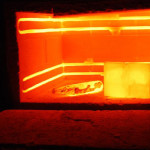what happens to metal pipe when heated with 100°c liquid
The electrical, magnetic and structural properties of metals can exist changed through heat. As the applications of metal are varied, different environments prioritize dissimilar qualities. For case, in engineering applications, toughness is desired; in electrical applications, low electric resistivity is of import.
There are a number of ways of heating metal which are commonly used to transform these backdrop. The temperature to which the metallic is heated and the rate of cooling are carefully controlled to attain the desired consequence.
The Result of Oestrus on Metallic 
The most important ways that metals are transformed through rut:
- Electric Resistance
- Thermal Expansion
- Structure
- Magnetism
Electrical Resistance
Electrical resistance is the measure of how strongly the metallic impedes the passage of electrical current. As electrons pass through the metal, they besprinkle as they collide with the metallic structure. When the metal is heated, the electrons absorb more than energy and move faster. This leads to more scattering, thus increasing the amount of resistance. Thermometers actually use the change in electric resistance in a piece of wire to measure temperature.
Thermal Expansion
Metal expands when heated. Length, surface area and book will increment with temperature. The scientific term for this is thermal expansion. The caste of thermal expansion varies with unlike types of metal. Thermal expansion occurs because heat increases the vibrations of the atoms in the metal. Bookkeeping for thermal expansion is essential when designing metallic structures. An everyday example would be the design of household pipes, which must arrange expansion and wrinkle as the seasons change.
Structure
Metals are comprised of a symmetrical construction of atoms known equally an allotrope. Heating the metal volition readapt atoms from their position and the displaced atoms course a new construction. This process is known as allotropic phase transformation. Allotropic phase transformation alters the hardness, strength and ductility of the metallic. The most important allotropic phase transformation is undergone past iron. When iron is heated past 1,674 degrees Fahrenheit information technology is able to absorb more carbon, which is an ingredient that will increase the hardness of any steel product. This desired effect is used in several types of High Carbon (above 0.50 carbon) steel – Example: Tool Steel
Magnetism
There are three metals with magnetic properties: iron, nickel and cobalt. They are known as ferromagnetic metals. Heating these metals will reduce their magnetization to the bespeak where magnetism is completely eradicated. The temperature at which this occurs is known as the Curie temperature. For nickel, this temperature is 626 degrees Fahrenheit; for cobalt it is 2,012 degrees Fahrenheit; and for Iron it is 1,418 degrees Fahrenheit.
Heat Handling
Heat handling is a process designed to alter the properties of the metal to better suit its intended use. The main types of heat handling are:
- Annealing
- Normalising
- Hardening
- Tempering
Annealing
Annealing is ofttimes used to soften metals including iron, steel, copper, brass and silver. The process involves heating the metal to a specific temperature then allowing it to absurd slowly at a controlled rate. Annealing alters the concrete and chemical properties of the metal to increment ductility and reduce hardness. This facilitates shaping, stamping or forming processes, and allows the metal to exist cut more easily. Annealing likewise enhances electric conductivity.
Normalising
Normalising (ordinarily referred to as normalized) is practical to alloys to provide uniformity in grain size and composition. The metallic is heated to a predefined temperature so cooled by air. The resulting metallic is free of undesirable impurities and exhibits greater strength and hardness. Normalising is often used to produce a harder and stronger steel, albeit one that is less ductile than that produced past annealing. Typically, the normalising process is performed on materials that will be subjected to machining, because the process has improved this attribute.
Hardening
Hardening is applied to steel and other alloys to improve their mechanical backdrop. During hardening, the metal is heated at a high temperature and this temperature is maintained until a proportion of carbon has been dissolved. Side by side the metallic is quenched, which involves quickly cooling information technology in oil or water. Hardening will produce an alloy which has high strength and wear resistance. All the same hardening volition also increase brittleness and is not suitable for engineering applications. When there is a need to have the surface of the component hard enough to resist wear and erosion, while maintaining ductility and toughness to withstand impact and stupor loading — surface hardening would be used.
Tempering
Tempering is applied to steel where ductility is desired. Untempered steel is very difficult but too breakable for virtually practical applications. Tempering is a low temperature heat treatment process normally performed after hardening (neutral hardening, double hardening, atmospheric carburising, carbonitriding, or induction hardening) in order to accomplish a desired hardness/toughness ratio. The process involves heating steel to a lower temperature to reduce some of the excess hardness. The metallic is so immune to absurd in still air which results in a tougher and less brittle steel.
Source: https://www.metalsupermarkets.com/how-heating-metal-affects-its-properties/

0 Response to "what happens to metal pipe when heated with 100°c liquid"
Post a Comment